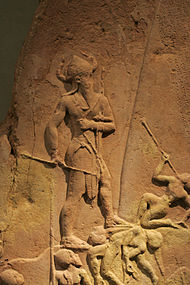- Naram-Sin of Akkad
-
Naram-Sin 
Naram-Sin depicted on his victory steleBorn Naram-Sin Other names Naram-Suen Predecessor Manishtushu Successor Shar-Kali-Sharri Children Shar-Kali-Sharri Parents Manishtushu (father)
unknown motherRelatives Sargon of Akkad (grandfather)
Tashlultum (grandmother)
Rimush (uncle)
En-hedu-ana (aunt)This article is about the Akkadian king. For other historical figures of the name, see Naram-Suen (disambiguation).Naram-Sin (also transcribed Narām-Sîn, Naram-Suen, Sin or Suen being the Akkadians' moon god equivalent to the Sumerian Nanna), reigned ca. 2254–2218 BCE, short chronology, was the third successor and grandson of King Sargon of Akkad. Under Naram-Sin the Akkadian Empire reached its zenith. He was the first Mesopotamian king known to have claimed divinity for himself, and one of the first (following the earlier Lugal-Anne-Mundu) to be called "King of the Four Quarters".
Contents
Biography
Naram-Sin was born as a son of Manishtushu. He was thus a nephew of King Rimush and grandson of Sargon and Tashlultum. Naram-Sin's aunt was the High Priestess En-hedu-ana.
Reign
Naram-Sin traded with Meluhha (possibly corresponding to the Indus Valley civilization), and controlled a large portion of land along the Persian Gulf. He expanded his empire by defeating the King of Magan at the southern end of the Persian Gulf, and conquering the hill tribes to the north in the Taurus Mountains. His famous "Victory Stele" depicts his triumph over Satuni, chief of Lullubi in the Zagros Mountains. The king list gives the length of his reign as 56 years, and at least 20 of his year-names are known, referring to military actions against various places such as Uruk and Subartu. One unknown year was recorded as "the Year when Naram-Sin was victorious against Simurrum in Kirasheniwe, and took prisoner Baba the governor of Simurrum, and Dubul the ensi of Arame".[1]
Other year names refer to his construction work on temples in Akkad, Nippur, and Zabala. He also built administrative centers at Nagar (Tell Brak) and Nineveh.
One Mesopotamian myth has it that the goddess Inanna abandoned the former capital of Akkad following Naram-Sin's plunder of the Ekur (temple of the god Enlil) in Nippur. In his anger, Enlil brought the Gutians down from the hills east of the Tigris, to bring plague, famine and death throughout Mesopotamia. To prevent this destruction, eight of the gods decreed that Agade (Akkad) should be destroyed to spare the remaining cities. While this story may be mythological, it does suggest that Gutian raids were already beginning during this period.
Soon after the death of Naram-Sin, the Gutians invaded Akkad. By around 2124 BC, all Akkad was in the hands of the Gutians. The Gutians remained there for 125 years before being thrown out by the neo-Sumerian Empire.[2][3]
Victory stele
Naram-Sin's famed victory stele (illustration) depicts him as a god-king (symbolized by his horned helmet) climbing a mountain above his soldiers, and his enemies, the defeated Lullubi. Although the stele was broken off at the top when it was stolen and carried off by the Elamites, it still strikingly reveals the pride, glory, and divinity of Naram-Sin. The stele broke from tradition by using successive diagonal tiers, rather than a horizontal format, to communicate the story to viewers. It is six feet and seven inches tall, and made from pink sandstone.[4]
The stele was found at Susa, and is now in the Louvre Museum.[5] A similar bas-relief depicting Naram-Sin was found a few miles north-east of Diarbekr, at Pir Hüseyin.
Children
The only known son of Naram-Sin was his successor Shar-Kali-Sharri.
See also
- Bassetki statue
- History of Sumer
- Sumerian king list
References
- ^ Year-Names of Naram-Sin of Agade
- ^ Babylonian Life and History, by E. A. Wallis Budge
- ^ Mesopotamia. British Museum Press. 2000. pp. 67–68. ISBN 0714121819. OCLC 43501084.
- ^ Kleiner, Fred (2005). Gardner's Art Through The Ages. Thomson-Wadsworth. p. 41. ISBN 0-534-64095-8.
- ^ Louvre ( Arts and Architecture). Köln: Könemann. ISBN 3-8331-1943-8.
Sources
- H.W.F. Saggs, The Babylonians, Fourth Printing, 1988, Macmillan Publishers Ltd.
- J. P. Naab, E. Unger, Die Entdeckung der Stele des Naram-Sin in Pir Hüseyin, Istanbul Asariatika Nesriyati XII (1934)[1].
External links
Notable Sumerians Ante-Diluvian kings Alulim · Dumuzid the Shepherd · Ziusudra 3rd Dynasty of Kish Kubaba 1st Dynasty of Kish Etana · Enmebaragesi 3rd Dynasty of Uruk Lugal-zage-si 1st Dynasty of Uruk Enmerkar · Lugalbanda · Dumuzid, the Fisherman · Gilgamesh Dynasty of Akkad Sargon · Tashlultum · Enheduana · Rimush · Manishtushu ·
Naram-Sin · Shar-Kali-Sharri · Dudu · Shu-turul1st Dynasty of Ur Meskalamdug · Mesannepada · Puabi 2nd Dynasty of Uruk Enshakushanna 2nd Dynasty of Lagash Puzer-Mama · Gudea 1st Dynasty of Lagash Ur-Nanshe · Eannatum · En-anna-tum I · Entemena · Urukagina 5th Dynasty of Uruk Utu-hegal Dynasty of Adab Lugal-Anne-Mundu 3rd dynasty of Ur Ur-Nammu · Shulgi · Amar-Sin · Shu-Sin · Ibbi-Sin Categories:- Sumerian rulers
- Akkadian people
- 22nd-century BC people
- Deified people
- Iraqi people
- 3rd-millennium BC births
- 3rd-millennium BC deaths
Wikimedia Foundation. 2010.
